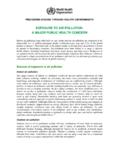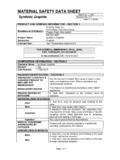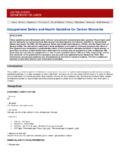Transcription of CARBON MONOXIDE EXHAUST SYSTEM DESIGN CRITERIA ...
1 CARBON MONOXIDE EXHAUST SYSTEM DESIGN CRITERIA FOR vehicle maintenance FACILITIESIt is important to understand that this contaminant is a known and lethal health hazard. Before attempting to DESIGN a SYSTEM , it is imperative that sufficient information about the application is gathered so that the designed SYSTEM will provide the end user with a safe work environment. A sample SYSTEM DESIGN Worksheet (form 1) is attached. Make sure that the largest engine to be tested is identified. It is essential that the end user provide this information at the start of the DESIGN process. For the installed SYSTEM to function correctly, the sizing of the connecting hose, ducting and fan must be determined based on the type of vehicle , type of engine, cubic inch displacement, and testing requirements.
2 vehicle EXHAUST Systems differ from other types of air handling applications in several ways. First, the air being conveyed contains a high concentration of health related hazardous materials including carcinogenic contaminants. It frequently enters the SYSTEM in a super heated state, under pressure and at high velocity, creating a rapidly expanding gaseous compound. The EXHAUST SYSTEM to be designed must have sufficient air flow capability to overcome the flow rate as well as the expansion rate of the EXHAUST gasses with a negative pressure SYSTEM . In addition, it must not have an affect on the performance of the engine being tested by creating either a backpressure or vacuum condition, which can alter the readings on the testing instruments.
3 For this reason selection of the connecting components to the EXHAUST pipe, hose size, and air flow rate are critical with the end user regarding the type and location of the EXHAUST pipes, along with engine information and testing requirements is essential when reviewing prospective manufacturers of the EXHAUST systems to be used as the basis of specification. DESIGN professionals in the vehicle EXHAUST industry are available and typically willing to provide assistance. They should be consulted regarding application requirements and current product : AUTO/LIGHT TRUCKMost of the vehicles in this category have gas engines up to 400 cu/in, and small diesel engines up to 300 cu/in. Current building codes dictate 300 CFM per bay as an EXHAUST air requirement through a source capture SYSTEM .
4 This is adequate in most cases; however, many auto manufactures offer diesel trucks with 6+ liter diesel engines. These require 450 CFM to handle the required high idle run tests. In facilities that maintain these vehicles, several bays need to be dedicated for this use and have an EXHAUST pick up, ducting and fan sized accordingly. Designers and Manufacturers of Custom Air Pollution Control Systems1225 Davis Road Elgin, Illinois 60123847 695 9000 Fax No: 847 695 9078 Car-Mon Products, DESIGN : AUTO/LIGHT TRUCKU nderfloor duct systems with floor receptacles offer convenient location of EXHAUST ports close to auto tailpipes and require a minimum of hose; overhead ducted systems, however may be preferred. With either DESIGN , a single EXHAUST pickup should be located between each car bay so that which ever side the EXHAUST pipe is located on, there will be an EXHAUST hose within easy reach.
5 In the case of dual EXHAUST vehicles, a hose from each side can be used and on the rare occasion where two adjacent vehicles, one or both having a dual EXHAUST , are to be run simultaneously, Y assemblies can be provided to accommodate venting each of the vehicles at the same time. Two vehicles should never be required to be vented through the same EXHAUST EXHAUST is an expanding contaminant that needs to be conveyed at higher velocity than typical air moving systems to minimize the expansion effect. For this reason duct sizing should be based on 2500 fpm. In underfloor systems, the minimum pipe diameter is based on the size requirements for the floor receptacle. As a result, velocities in ducting farthest away from the fan may appear low, however, where hose assemblies are stored in the under floor duct, much of the cross sectional area is obstructed, allowing the flow rate to be adequate for a functional SYSTEM .
6 Schedule 40 PVC pipe is an acceptable ducting medium for conventional underfloor systems*, galvanized spiral pipe for minimum 5 static pressure is acceptable for overhead systems. Since EPA regulations do not allow direct drainage of these systems to ground water, additional considerations for underfloor systems need to include provisions for removal of water that may inadvertently collect in the SYSTEM and the collection of debris that may be swept and/or sucked into the SYSTEM . An illustration of a trunk and riser duct arrangement is included (illustration 1) that incorporates a dry sump for collection and evaporation of condensation along with a screened refuse cleanout plenum for preventing debris from being drawn into the fan.
7 *Stainless steel spiral should be used in underfloor dyno applications in place of in the connecting hose needs to be at least 3400 fpm for effective capture and conveyance of the EXHAUST at the tail pipe. For this reason 4 diameter hose is used in providing the 300 CFM per bay requirement for gas cars/light trucks and 5 diameter for diesel pickup trucks removing 450 CFM. The configuration of the adapter that actually connects to the EXHAUST pipe and the manner in which it attaches is a matter of choice. The end user should participate in this selection. Taking the time to review product literature and requesting samples for evaluation is extremely auto and light truck no-load testing, the EXHAUST hose should be rated for a minimum of 375F continuous exposure.
8 The approach to hose storage relates to both SYSTEM configuration and cost. For the underfloor receptacle (illustration 2), hose storage is accomplished by sliding the flexible hose assembly into the floor receptacle; for overhead systems two basic types are available, hanging hoses affixed directly to the ducting and storage reels to which the hose is attached and wound up. The hanging hose (illustration 3) can be pulled up to store above head height by hand with either a rope and pulley, cable and winch, or spring balancer. In addition there is a telescoping hose assembly available. If using storage reels (illustration 4), retraction can be accomplished with a hand winch, spring retractor, or power operator.
9 Total SYSTEM costs will vary considerably based on both equipment selection and installation considerations. It is important to understand the needs and budget of the end user at the beginning of the DESIGN process. APPLICATION: DIESEL ENGINE VEHICLESThe use of diesel engines is extremely diverse, utilizing a wide range of engine size and power requirements. It is important to note that not all diesel engines power vehicles, many power equipment such as pumps, generators, and compressors. While most diesel engines are 4 cycle, there is a sizable number of 2 cycle engines in use, most are turbo charged and all 2 cycle engines produce twice as much EXHAUST as the same cubic inch displacement 4 cycle engine.
10 Where automobile maintenance facilities have less diversity in engine size, diesel shops can be exposed to a much wider range of sizes and types of engines. It is therefore, imperative that accurate information about the application be obtained at the beginning of the DESIGN are four ranges of operating performance to deal with in designing a SYSTEM for exhausting the output from turbo diesel engines: idle running only, no-load testing through maximum RPM, partial load for hydraulic testing, and full load dynamometer testing. The following chart provides an approximate EXHAUST CFM requirement per cu/in for 4 cycle* turbo diesel engines: IDLE RUNNING ONLYCU/IN X .6NO-LOAD TESTING TO 2100 RPMCU/IN X LOAD/HYDRAULIC TESTINGCU/IN X LOAD DYNAMOMETER TESTING**CU/IN X *To determine CFM requirements for 2cycle engines, multiply the 4 cycle total by 2.









